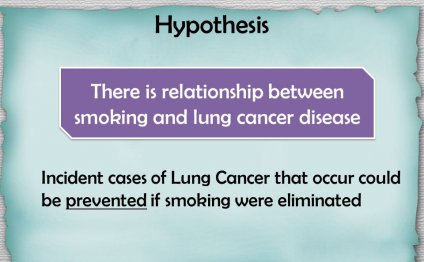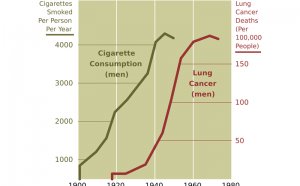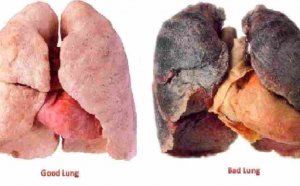
Relationship between smoking and lung cancer
The Department of Health and Human Service's (DHHS) 1982 report to Congress on the health consequences of smoking presents a comprehensive evaluation of the relationship between cigarette smoking and cancer. It identifies cigarette smoking as the major single cause of cancer mortality in the United States (1).
Since 1937 cancer has been the second most frequent cause of death in the United States and will account for an estimated 430, 000 deaths this year. The mortality rate for cancer, unlike the declining rates for other chronic diseases, has changed little over 2 decades, and that change has been a small but measurable increase. This increase in mortality has occurred in the face of remarkable improvements in survival rates associated with some cancer sites through earlier or better diagnosis and treatment. Unfortunately, however, these advances have failed to counter the increases in mortality from smoking-related cancer.
Tobacco's contribution to cancer deaths is currently estimated to be 30%. This means that 129, 000 Americans are likely to die of cancer this year because of the higher overall cancer death rates for smokers as compared with nonsmokers. Cigarette smokers have total cancer death rates that are 2 times greater than those for nonsmokers. Heavy smokers (those who smoke more than 1 pack a day) have a 3-4 times greater excess risk of cancer mortality. Lung Cancer and Smoking
Cigarette smoking is the major cause of lung cancer in the United States. Lung cancer alone accounts for fully 25% of all cancer deaths in this country; it is estimated that 85% of lung-cancer cases are due to cigarette smoking. The number of lung-cancer deaths in the United States increased from 18, 313 in 1950 to 90, 828 in 1977.
The American Cancer Society estimates that 111, 000 persons will die of lung cancer in 1982-80, 000 men and 31, 000 women. The lung-cancer death rate for women is currently rising faster than that for men, reflecting the more recent adoption of smoking by large numbers of women. When 5-year age-specific lung cancer mortality rates for white females are plotted by calendar year and age, the 3-dimensional graph of lung-cancer mortality (Figure 1) shows a sharp increase in recent years. If these trends continue, the lung-cancer death rate for women will soon surpass that of breast cancer, currently the leading cause of cancer mortality in women. The 5-year survival rate for lung cancer is less than 10%. This rate has not changed appreciably in over 15 years. Lung Cancer and Involuntary Exposure to Smoking
The DHHS report states that 3 epidemiologic studies examined involuntary or passive smoking and lung cancer in nonsmokers this past year. Two studies found a statistically significant correlation between involuntary smoking and lung-cancer risk in nonsmoking wives of men who smoked. The third noted a positive, but not statistically significant, association. While the nature of this association is unresolved, it does raise the concern that involuntary smoking may pose a carcinogenic risk to the nonsmoker. Cancer of the Larynx, Oral Cavity, and Esophagus
VIDEO REVIEWS



Share this Post
Related posts
Cigarette smoking and lung cancer
The American Lung Association is concerned about the health impacts of marijuana use, especially on lung health. We caution…
Read MoreTobacco and lung cancer
What s the difference between chewing and spit (or snuff) tobacco? Chewing tobacco ( chaw ) is usually sold as leaf tobacco…
Read More
 Smoking cessation (colloquially quitting smoking) is the process of discontinuing the practice of inhaling a smoked substance. This article focuses exclusively on cessation of tobacco smoking; however, the methods described may apply to cessation of smoking other...
Smoking cessation (colloquially quitting smoking) is the process of discontinuing the practice of inhaling a smoked substance. This article focuses exclusively on cessation of tobacco smoking; however, the methods described may apply to cessation of smoking other...










